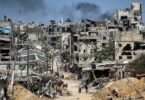Khazar Ibrahim
Over the past two centuries, our ancestors in the Southern Caucasus and Asia Minor were constantly subjected to massacres and genocides as a result of persecution at the hands of Armenians. Starting in the 19th century, Armenian nationalists spread in the Southern Caucasus with the help of their supporters following their fabricated ideals to create a “Greater Armenia” in the region. As a result, local people were expelled from their homeland, and mass killings and destruction of their settlements and historical and religious monuments and cultural heritage took place. The four ethnic cleansings carried out by Armenians in the region in 1905 to 1907, 1918 to 1920, 1948 to 1953 and 1988 to 1989 show their true intentions.
To understand the causes of these events, we should consider the historical background of Armenian-Azerbaijani contradictions in the region. In order to reach a better understanding of its essence, we have to go back to the 18th and early 19th centuries, to the very origins of the conflict. The dismemberment of the Azerbaijani people and the division of historical Azerbaijan began with the Treaties of Gulistan and Turkmanchay, signed in 1813 and 1828, respectively. The national tragedy of a divided Azerbaijan continued with the occupation of Azerbaijani land. As a result of an implemented ethnic cleansing policy, a very rapid mass resettlement by Armenians in Azerbaijani land took place and the policy of genocide became an integral part of the occupation. Inspired by dreams of creating a “Greater Armenia,” Armenians carried out a series of large-scale, bloody attacks on Azerbaijanis between 1905 and 1907. Hundreds of settlements were destroyed and burned to the ground and thousands of Azerbaijanis were barbarically killed.
Taking advantage of the situation following World War I, and the February and October 1917 revolutions in Russia, Armenian nationalists again began to pursue the implementation of their plans under the banner of Bolshevism. In 1918, the leader of the Russian Bolsheviks, Vladimir Lenin, appointed Stephan Shaumyan as the extraordinary commissar of the Caucasus and sent him to Baku. The Bolsheviks seized power in Baku and created the conditions for the Armenian armed formations to realize their secret plans. On March 3, the mass slaughters of the Azerbaijanis began. According to Stephan Shaumian, 6,000 armed soldiers of Soviet Baku and 4,000 armed men from the Armenian Revolutionary Federation took part in the massacre of peaceful Azerbaijanis.
The policy of genocide and deportation carried out by Armenians against Azerbaijanis intensified even more in 1918 and continued into the 1920s. The largest massacre was committed on March 30, 1918, when hundreds of Azerbaijani towns and villages were destroyed, 150 Azerbaijani villages in Karabakh were left in ruin and unprecedented bloodshed was seen in Shusha. More than 700,000 Azerbaijanis were slaughtered in what became known as the March Days, including 30,000 in Baku and its surrounding villages, were brutally murdered and mosques and schools were burned.
The declaration of independence in 1918 enabled Azerbaijan to investigate crimes against the Azerbaijani and Muslim population. One of the significant decisions of the newly formed government of Azerbaijan was the establishment of an Extraordinary Investigation Commission on June 15, 1918 that investigated and documented countless crimes committed by Dashnak gangs. The bloody events from 1918 to 1920 are vividly echoed in many foreign witnesses’ memoirs, books and articles, as well as reports of British mission representatives in the Southern Caucasus who were sent to the region on a special mission by the British government and noted that Armenian armed forces were disdainful, used the most insidious methods to annihilate Azerbaijani civilians in the Karabakh, Zangezur and Nakhchivan districts of Azerbaijan. A burial site was found during construction work in 2007 in the city of Guba in the northeast. In the site, Azerbaijanis who were tortured and killed by Armenian Dashnaks in 1918 and the remains of Lezgins, Tats, Avars, Jews and other ethnic groups were found. The Guba Genocide Memorial Complex, an open-air museum inaugurated by Azerbaijani President Ilham Aliyev stands as a chilling reminder of the Armenian atrocities.
It should be noted that the Ottoman Empire, also in a difficult situation at the time and facing the same atrocities from Armenian gangs in its eastern provinces, sent the Islamic Army of the Caucasus to Azerbaijan led by Nuru Pasha in 1918. Therefore, the army’s contribution to the liberation of Baku and the surrounding regions from Armenian-Bolshevik occupation is a great moment in Azerbaijani-Turkish relations.
During the Soviet era, all of these events were pushed aside under the slogan of peoples’ friendship. However, Azerbaijan’s late president Haydar Aliyev provided political recognition of the events with a decree on March 26, 1998, to announce the bloody murders committed by Armenians to the world and, by doing so, protect the national memory for future generations and immortalize the memories of the victims of the genocide.
Unfortunately, the modern world witnessed similar atrocities again in the 20th century. Since 1988, a conflict sparked by Armenian territorial claims and Armenia’s policy of aggression against Azerbaijan resulted in the occupation of 20 percent of the country’s territory, including Nagorno-Karabakh and seven other districts in Azerbaijan. Hundreds of thousands of Azerbaijanis became refugees or were internally displaced. On Feb. 25, 1992, the Armenian armed forces attacked the town of Khojaly from all sides and committed crimes against the civilians. A total of 613 people from Khojaly, among them 106 women, 63 children and 70 elderly, were tortured to death, 487 were left disabled and 1,275 were taken as prisoners and subjected to persecution and insults.
Armenia controls one-fifth of Azerbaijan’s territory and still rejects four U.N. Security Council resolutions demanding the unconditional withdrawal of its armed forces. Commemorating the 100th year since the Armenian Dashnak massacre of Azerbiajanis in March 1918 and hoping that Khojaly is the last chain of the Armenia’s mentality of terror, we all are obliged to tell the truth about those atrocities so they never happen again anywhere else in the world.






